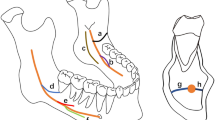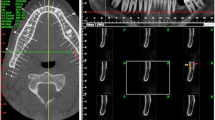Abstract
Objective
The physiology of the mandibular nerve is an important factor relevant to successful implant planning and surgical procedures in the mandible. Variability among ethnicities may influence the particular safety guidelines for each population. In this study, we retrospectively examined the incidences of canal orientations and variations in Thais using cone-beam computed tomography (CBCT) radiography.
Methods
CBCT images of 441 mandibular sides of 248 patients aged 20 to 82 years (mean age, 43.7 years) were examined. The incidences of canal courses and variations were assessed by two calibrated observers (Cohen's kappa coefficient >0.8). Descriptive and bivariate statistics were analysed for categorical findings. A p value of <0.05 was considered statistically significant.
Results
Two common canal courses were identified: linear curve (Type 1, 39.9%) and elliptic-arc curve (Type 3, 48.1%). In addition, one-fifth of the patients had bifid canals (20.6%). There was a short supplemental canal extending to the second or third molar (Type 2, 53.8%) and a supplemental canal arising in the retromolar pad region (Type 4, 46.2%). An anterior loop was identified in 74.2% of the cases and was frequently bilateral (78.3%).
Conclusions
Effective examination of the canal anatomy should be considered prior to surgical procedures because of the shallow curve of the mandibular canal with a high incidence of an anterior loop. In addition, the position of bifid canals was associated with an increased risk of neurovascular alteration in implant placement, sagittal split ramus osteotomy, and retromolar bone harvesting.



Similar content being viewed by others
References
Liu T, Xia B, Gu Z. Inferior alveolar canal course: a radiographic study. Clin Oral Implants Res. 2009;20:1212–8.
Ozturk A, Potluri A, Vieira AR. Position and course of the mandibular canal in skulls. Oral Surg Oral Med Oral Pathol Oral Radiol. 2012;113:453–8.
Nortje CJ, Farman AG, Grotepass FW. Variations in the normal anatomy of the inferior dental (mandibular) canal: a retrospective study of panoramic radiographs from 3612 routine dental patients. Br J Oral Surg. 1977;15:55–63.
Naitoh M, Hiraiwa Y, Aimiya H, Ariji E. Observation of bifid mandibular canal using cone-beam computerized tomography. Int J Oral Maxillofac Implants. 2009;24:155–9.
Apostolakis D, Brown JE. The anterior loop of the inferior alveolar nerve: prevalence, measurement of its length and a recommendation for interforaminal implant installation based on cone beam CT imaging. Clin Oral Implants Res. 2012;23:1022–30.
Yosue T, Brooks SL. The appearance of mental foramina on panoramic radiographs. I. Evaluation of patients. Oral Surg Oral Med Oral Pathol. 1989;68:360–4.
Kuribayashi A, Watanabe H, Imaizumi A, Tantanapornkul W, Katakami K, Kurabayashi T. Bifid mandibular canals: cone beam computed tomography evaluation. Dentomaxillofac Radiol. 2010;39:235–9.
Uchida Y, Noguchi N, Goto M, Yamashita Y, Hanihara T, Takamori H, et al. Measurement of anterior loop length for the mandibular canal and diameter of the mandibular incisive canal to avoid nerve damage when installing endosseous implants in the interforaminal region: a second attempt introducing cone beam computed tomography. J Oral Maxillofac Surg. 2009;67:744–50.
Langlais RP, Broadus R, Glass BJ. Bifid mandibular canals in panoramic radiographs. J Am Dent Assoc. 1985;110:923–6.
Rouas P, Nancy J, Bar D. Identification of double mandibular canals: literature review and three case reports with CT scans and cone beam CT. Dentomaxillofac Radiol. 2007;36:34–8.
Claeys V, Wackens G. Bifid mandibular canal: literature review and case report. Dentomaxillofac Radiol. 2005;34:55–8.
Wismeijer D, van Waas MA, Vermeeren JI, Kalk W. Patients’ perception of sensory disturbances of the mental nerve before and after implant surgery a prospective study of 110 patients. Br J Oral Maxillofac Surg. 1997;35:254–9.
Ngeow WC, Dionysius DD, Ishak H, Nambiar P. A radiographic study on the visualization of the anterior loop in dentate subjects of different age groups. J Oral Sci. 2009;51:231–7.
Parnia F, Moslehifard E, Hafezeqoran A, Mahboub F, Mojaver-Kahnamoui H. Characteristics of anatomical landmarks in the mandibular interforaminal region: a cone-beam computed tomography study. Med Oral Patol Oral Cir Bucal. 2012;17:e420–5.
Monsour PA, Dudhia R. Implant radiography and radiology. Aust Dent J. 2008;53(Suppl 1):S11–25.
Park JB. The evaluation of digital panoramic radiographs taken for implant dentistry in the daily practice. Med Oral Patol Oral Cir Bucal. 2010;15:e663–6.
Jensen C, Raghoebar GM, Meijer HJ, Schepers R, Cune MS. Comparing two diagnostic procedures in planning dental implants to support a mandibular free-ending removable partial denture. Clin Implant Dent Relat Res. 2015. doi:10.1111/cid.12359.
Vazquez L, Saulacic N, Belser U, Bernard JP. Efficacy of panoramic radiographs in the preoperative planning of posterior mandibular implants: a prospective clinical study of 1527 consecutively treated patients. Clin Oral Implants Res. 2008;19:81–5.
Nikneshan S, Aval SH, Bakhshalian N, Shahab S, Mohammadpour M, Sarikhani S. Accuracy of linear measurement using cone-beam computed tomography at different reconstruction angles. Imaging Sci Dent. 2014;44:257–62.
Eshak M, Brooks S, Abdel-Wahed N, Edwards PC. Cone beam CT evaluation of the presence of anatomic accessory canals in the jaws. Dentomaxillofac Radiol. 2014;43:20130259.
Orhan K, Icen M, Aksoy S, Ozan O, Berberoglu A. Cone-beam CT evaluation of morphology, location, and course of mandibular incisive canal: considerations for implant treatment. Oral Radiol. 2014;30:64–75.
Ludlow JB, Timothy R, Walker C, Hunter R, Benavides E, Samuelson DB, et al. Effective dose of dental CBCT-a meta analysis of published data and additional data for nine CBCT units. Dentomaxillofac Radiol. 2015;44:20140197.
Harris D, Horner K, Grondahl K, Jacobs R, Helmrot E, Benic GI, et al. E.A.O. guidelines for the use of diagnostic imaging in implant dentistry 2011. A consensus workshop organized by the European Association for Osseointegration at the Medical University of Warsaw. Clin Oral Implants Res. 2012;23:1243–53.
Mizbah K, Gerlach N, Maal TJ, Berge SJ, Meijer GJ. The clinical relevance of bifid and trifid mandibular canals. Oral Maxillofac Surg. 2012;16:147–51.
Lew K, Townsen G. Failure to obtain adequate anaesthesia associated with a bifid mandibular canal: a case report. Aust Dent J. 2006;51:86–90.
Sanchis JM, Penarrocha M, Soler F. Bifid mandibular canal. J Oral Maxillofac Surg. 2003;61:422–4.
Grover PS, Lorton L. Bifid mandibular nerve as a possible cause of inadequate anesthesia in the mandible. J Oral Maxillofac Surg. 1983;41:177–9.
Valarelli TP. Radiographic interpretation of the mandibular canal in panoramic radiographs. Rev Aca Tir Odo. 2007;7:432–49.
Fukami K, Shiozaki K, Mishima A, Kuribayashi A, Hamada Y, Kobayashi K. Bifid mandibular canal: confirmation of limited cone beam CT findings by gross anatomical and histological investigations. Dentomaxillofac Radiol. 2012;41:460–5.
Kang JH, Lee KS, Oh MG, Choi HY, Lee SR, Oh SH, et al. The incidence and configuration of the bifid mandibular canal in Koreans by using cone-beam computed tomography. Imaging Sci Dent. 2014;44:53–60.
Orhan K, Aksoy S, Bilecenoglu B, Sakul BU, Paksoy CS. Evaluation of bifid mandibular canals with cone-beam computed tomography in a Turkish adult population: a retrospective study. Surg Radiol Anat. 2011;33:501–7.
Kuzmanovic DV, Payne AG, Kieser JA, Dias GJ. Anterior loop of the mental nerve: a morphological and radiographic study. Clin Oral Implants Res. 2003;14:464–71.
Mardinger O, Chaushu G, Arensburg B, Taicher S, Kaffe I. Anterior loop of the mental canal: an anatomical-radiologic study. Implant Dent. 2000;9:120–5.
Vujanovic-Eskenazi A, Valero-James JM, Sanchez-Garces MA, Gay-Escoda C. A retrospective radiographic evaluation of the anterior loop of the mental nerve: comparison between panoramic radiography and cone beam computerized tomography. Med Oral Patol Oral Cir Bucal. 2015;20:e239–45.
de Oliveira-Santos C, Souza PH, de Azambuja Berti-Couto S, Stinkens L, Moyaert K, Rubira-Bullen IR, et al. Assessment of variations of the mandibular canal through cone beam computed tomography. Clin Oral Investig. 2012;16:387–93.
Prapayasatok S, Janhom A, Mahasantipiya P, Charuakkra A, Pramojanee S, Verochana K. A CBCT study of the anterior loop of the mental canal in Thais. CM Dent J. 2016;37:103–14.
Raitz R, Shimura E, Chilvarquer I, Fenyo-Pereira M. Assessment of the mandibular incisive canal by panoramic radiograph and cone-beam computed tomography. Int J Dent. 2014;2014:187085.
Acknowledgements
This study was funded by the Faculty of Dental Medicine, Rangsit University. The authors are grateful to Dr. Watcharin Chongkonsatit, Ph.D., and Dr. Chalermrat Chantaradecha, Ph.D., who provided statistical advice. The authors also thank Asst. Prof. Dr. Kraisorn Sappayatosok, DDS, Ph.D., and Dr. Ozgur Erdogan, DDS, Ph.D., for their support.
Author information
Authors and Affiliations
Corresponding author
Ethics declarations
Conflict of interest
Piyanuch Karnasuta, Jananya Plianrungsi, Issarintip Denkongpon, Nantida Horsimasathaporn, Panthipa Chayutthanabun, Jariya Weerachartwattana, Pajaree Boonchalermchai, Sukanya Charoenwathana, Nattasit Narongrat, Kwanporn Jutipimarn, Natthawit Hongsatit, and Wichit Tharanon have no conflicts of interest.
Human rights statements and informed consent
All procedures followed were in accordance with the ethical standards of the responsible committee on human experimentation (institutional) and with the Helsinki Declaration of 1964 and later versions.
Animal rights statement
This article does not contain any studies with animal subjects performed by any of the authors.
Rights and permissions
About this article
Cite this article
Karnasuta, P., Plianrungsi, J., Denkongpon, I. et al. Cone-beam computed tomography investigation of crucial mandibular canal variations in Thais. Oral Radiol 33, 219–226 (2017). https://doi.org/10.1007/s11282-017-0270-3
Received:
Accepted:
Published:
Issue Date:
DOI: https://doi.org/10.1007/s11282-017-0270-3




